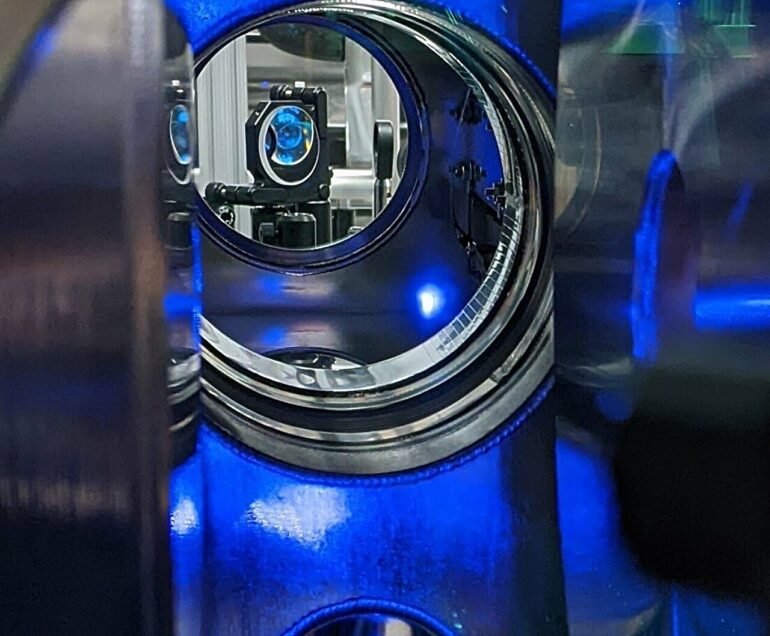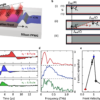Assuming dark matter exists, its interactions with ordinary matter are so subtle that even the most sensitive instruments cannot detect them. In a new study, Northwestern University physicists now introduce a highly sensitive new tool, which amplifies incredibly faint signals by 1,000 times—a 50-fold improvement over what was previously possible.
Called an atom interferometer, the incredibly precise tool manipulates atoms with light to measure exceptionally tiny forces. But, unlike other atom interferometers, which are limited by the imperfections in the light itself, the new tool self-corrects for these imperfections to reach record-breaking levels of precision.
By boosting imperceptible signals to perceptible levels, the technological advance could help scientists who are hunting for ultra-weak forces emitted from a variety of evasive phenomena, including dark matter, dark energy and gravitational waves in unexplored frequency ranges.
The new study was published in Physical Review Letters.
“Dark matter is somewhat of an embarrassing problem,” said Northwestern’s Timothy L. Kovachy, who led the work. “It’s a weird dichotomy because the ordinary matter that we encounter in everyday life, we understand extremely well. But that only makes up 15% of the matter in the universe.
“We don’t know the nature of the rest, which makes up most of the matter in the universe. So, it’s just a big incompleteness. Atom interferometers could potentially have a big impact in searching for this kind of dark matter.”
Kovachy is an assistant professor of physics and astronomy at Northwestern’s Weinberg College of Arts and Sciences and a member of the Center for Fundamental Physics.
What is an atom interferometer?
Invented in 1991, atom interferometers take advantage of superposition, a fundamental principle in quantum mechanics that a particle can exist in multiple states simultaneously. In this case, an atom behaves like a wave that exists along two paths at once. In an atom interferometer, lasers split a wave-like atom into two waves, send those waves on two different paths and then recombine them.
When the waves recombine, they create a pattern, which is like a fingerprint that reveals forces acting on the atoms. By studying this pattern, scientists can measure tiny, invisible forces and accelerations.
“Atom interferometers are really good at measuring small oscillations in distances,” Kovachy said. “We don’t know how strong dark matter is, so we want our instruments to be as sensitive as they can be. Because we haven’t ‘seen’ dark matter yet, we know its effects must be pretty weak.”
The problem with current instruments
When working with waves this tiny, however, it doesn’t take much to disrupt the entire experiment. Even the tiniest imperfection can lead to errors in the interference pattern. A single photon, for example, can derail the wave-like atom’s path—kicking it off-course with a velocity of one-centimeter per second.
“Photons can’t carry that much momentum, but atoms also don’t have that much mass,” Kovachy explained. “If we lose one atom, that doesn’t seem like the end of the world. But if we apply many laser pulses of light to boost the atom interferometer’s ability to amplify small signals, those errors will compound. And they will compound fast. In practice, we saw that after about 10 pulses, the signal was just gone.”
Discover the latest in science, tech, and space with over 100,000 subscribers who rely on Phys.org for daily insights.
Sign up for our free newsletter and get updates on breakthroughs,
innovations, and research that matter—daily or weekly.
‘Self-correcting’ system
To overcome this challenge, Kovachy and his team developed a new technique to carefully orchestrate the sequence of laser pulses. Leveraging machine-learning approaches, the method “self-corrects” for the imperfections in individual pulses of light. By controlling the waveforms of laser pulses, the researchers reduced the overall effect of errors caused by imperfections in the experimental setup.
After testing the model in simulations, Kovachy’s team built the experiment in the lab. The experiments verified the signal was amplified by 1,000 times.
“Before, we could only do 10 laser pulses; now we can do 500,” Kovachy said. “This could be game changing for many applications. The atom interferometer as an entire entity ‘self corrects’ for the imperfections in each laser pulse. We can’t make each laser pulse perfect, but we can optimize the global sequence of pulses to correct for imperfections in each one. That could allow us to unlock the full potential of atom interferometry.”
More information:
Yiping Wang et al, Robust Quantum Control via Multipath Interference for Thousandfold Phase Amplification in a Resonant Atom Interferometer, Physical Review Letters (2024). DOI: 10.1103/PhysRevLett.133.243403 journals.aps.org/prl/abstract/ … ysRevLett.133.243403. On arXiv: DOI: 10.48550/arxiv.2407.11246
Provided by
Northwestern University
Citation:
Advanced atom interferometer could help with ‘the embarrassing problem’ of dark matter (2024, December 11)



